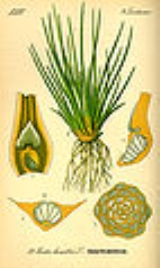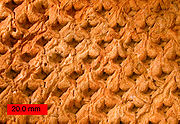
Isoetopsida
Encyclopedia
The Isoetopsida is a class of the Lycopodiophyta
. All living plants belong to the genus Selaginella in the Selaginellales or to Isoetes in the order Isoetales. In the past, members of this group have sometimes been placed in the class Isoetopsida, sometimes in the Selaginellopsida or Lycopodiopsida. There are about 700 species of Selaginella and 140-150 species of Isoetes, with a cosmopolitan distribution
but often scarce to rare. Some botanists split Isoetes, separating two South American species into the genus Stylites.
Some workers prefer the name Selaginellopsida A.B. Frank 1877, which has priority over the name Isoetopsida; the latter was not published until 1885. However, priority does not apply above the rank of family. Recent articles favor the name Isoetopsida, since Selaginellopsida sometimes is ambiguously used. It may have the same membership as the Isoetopsida described here, or it may include only the order Selaginellales.
 The most famous group within the Isoetopsida is the "scale trees" (order Lepidodendrales
The most famous group within the Isoetopsida is the "scale trees" (order Lepidodendrales
), which include Lepidodendron
. These massive trees flourished in marshlands of the Carboniferous
. Quillworts are considered by some to be the last remnant of such fossil
trees, with which they share some unusual features including the development of both wood
and bark, a modified shoot system acting as roots, bipolar growth, and an upright stance.
Lycopodiophyta
The Division Lycopodiophyta is a tracheophyte subdivision of the Kingdom Plantae. It is the oldest extant vascular plant division at around 410 million years old, and includes some of the most "primitive" extant species...
. All living plants belong to the genus Selaginella in the Selaginellales or to Isoetes in the order Isoetales. In the past, members of this group have sometimes been placed in the class Isoetopsida, sometimes in the Selaginellopsida or Lycopodiopsida. There are about 700 species of Selaginella and 140-150 species of Isoetes, with a cosmopolitan distribution
Cosmopolitan distribution
In biogeography, a taxon is said to have a cosmopolitan distribution if its range extends across all or most of the world in appropriate habitats. For instance, the killer whale has a cosmopolitan distribution, extending over most of the world's oceans. Other examples include humans, the lichen...
but often scarce to rare. Some botanists split Isoetes, separating two South American species into the genus Stylites.
Some workers prefer the name Selaginellopsida A.B. Frank 1877, which has priority over the name Isoetopsida; the latter was not published until 1885. However, priority does not apply above the rank of family. Recent articles favor the name Isoetopsida, since Selaginellopsida sometimes is ambiguously used. It may have the same membership as the Isoetopsida described here, or it may include only the order Selaginellales.

Lepidodendrales
Lepidodendrales were primitive, vascular, arborescent plants related to the lycopsids . They thrived during the Carboniferous period, and some reached heights of over 30 meters, with trunks often more than one meter in diameter...
), which include Lepidodendron
Lepidodendron
Lepidodendron is an extinct genus of primitive, vascular, arborescent plant related to the Lycopsids . It was part of the coal forest flora. They sometimes reached heights of over , and the trunks were often over in diameter, and thrived during the Carboniferous period...
. These massive trees flourished in marshlands of the Carboniferous
Carboniferous
The Carboniferous is a geologic period and system that extends from the end of the Devonian Period, about 359.2 ± 2.5 Mya , to the beginning of the Permian Period, about 299.0 ± 0.8 Mya . The name is derived from the Latin word for coal, carbo. Carboniferous means "coal-bearing"...
. Quillworts are considered by some to be the last remnant of such fossil
Fossil
Fossils are the preserved remains or traces of animals , plants, and other organisms from the remote past...
trees, with which they share some unusual features including the development of both wood
Wood
Wood is a hard, fibrous tissue found in many trees. It has been used for hundreds of thousands of years for both fuel and as a construction material. It is an organic material, a natural composite of cellulose fibers embedded in a matrix of lignin which resists compression...
and bark, a modified shoot system acting as roots, bipolar growth, and an upright stance.

